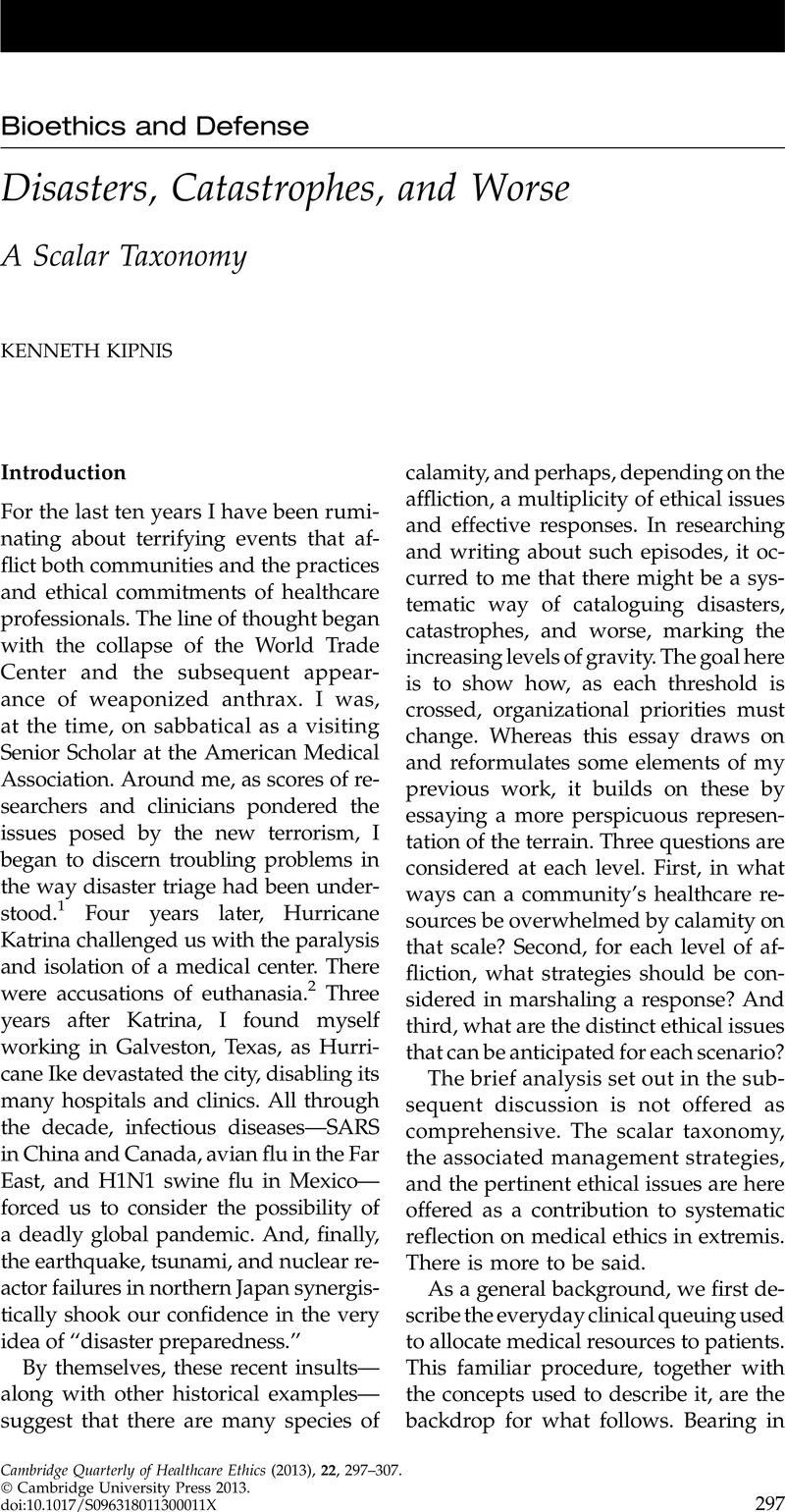Article contents
Disasters, Catastrophes, and Worse
A Scalar Taxonomy
Published online by Cambridge University Press: 30 April 2013
Abstract

- Type
- Bioethics and Defense
- Information
- Copyright
- Copyright © Cambridge University Press 2013
References
Notes
1 Those early efforts gave rise to Kipnis, K.Overwhelming casualties: Medical ethics in a time of terror. In: Moreno, J, ed. In the Wake of Terror: Medicine and Morality in a Time of Crisis. Cambridge: MIT Press; 2003:95–107.Google Scholar The present work owes much to suggestions from Griffin Trotter, Ron Bontekoe, and Laura Specker Sullivan.
2 I explore the ethical issues raised by Katrina in Kipnis, K.Forced abandonment and euthanasia: A question from Katrina. Social Research 2007;74:79–100.Google Scholar
3 There are some other conditions that can temporarily disrupt clinical practice.
4 Winslow, GR. Triage and Justice. Berkeley: University of California Press; 1982.Google Scholar
5 The single exception would be healthcare or rescue personnel who, if treated, could be returned to life-saving duty within the period of scarcity. As a practical matter, it is useful if the walking wounded attend to the needs of expectant patients.
6 Landrigan CP, Rothschild JM, Cronin JW, Kaushal R, Burdick E, Katz JT, et al., for the Harvard Work Hours, Health and Safety Group. Effect of reducing interns’ work hours on serious medical errors in intensive care units. N Engl J Med 2004;351:1838–48. Cited 10 Oct 2011.
7 Durham, TW, McCammon, SL, Allison, EJ Jr. The psychological impact of disaster on rescue personnel. Annals of Emergency Medicine 1985;14(7):664–8.CrossRefGoogle ScholarPubMed
8 Note that this clinically focused definition is narrower than the broader social conception of catastrophe developed by E. L. Quarantelli. See Quarantelli EL. Catastrophes are Different from Disasters: Some Implications for Crisis Planning and Managing Drawn from Katrina; 2006 June 11; available at http://understandingkatrina.ssrc.org/Quarantelli (last accessed 7 Oct 2011).
9 There are several pertinent discussions of the events at Memorial Medical Center. See Deichmann RE. Code Blue: A Katrina Physician’s Memoir. Bloomington: Author House; 2006; Meitrodt J. For dear life: How hope turned to despair at Memorial Medical Center. New Orleans Times-Picayune 2006 Aug 20–24; available at http://www.vendomeplace.org/press082006memorialhospital.html (last accessed 5 Aug 2011); see note 2, Kipnis 2007; and Fink S. The deadly choices at Memorial. New York Times Magazine 2009 Aug 30:28; available at http://www.nytimes.com/2009/08/30/magazine/30doctors.html (last accessed 5 Aug 2011).
10 Meitrodt 2006 and Deichmann 2006 (see note 9) recount such an announcement early Thursday morning, the fourth day after Katrina’s landfall.
11 The general form of the problem is ably set out in Swann, SW. Euthanasia on the battlefield. Military Medicine 1987;152:545–9.CrossRefGoogle ScholarPubMed I have proposed a practical approach in Kipnis 2007 (see note 2).
12 Del Bosque M. Storm over UTMB. Texas Observer 2009 Mar 20; available at http://findarticles.com/p/articles/mi_7757/is_200903/ai_n32205529/?tag=mantle_skin;content (last accessed 5 Aug 2011).
13 Sorenson, JH, Vogt, BM. Will Duct Tape and Plastic Really Work? Issues Related to Expedient Shelter-In-Place. Oak Ridge, TN: Oak Ridge National Laboratory; 2001Google Scholar; available at http://emc.ornl.gov/EMC/PDF/TM_2001_154_duct_plastic.pdf (last accessed 5 Aug 2011).
14 U.S. Department of Health and Human Services. Pandemics and Pandemic Threats since 1900; available at http://www.pandemicflu.gov/general/historicaloverview.html (last accessed 7 Oct 2011).
15 World Health Organization. Cumulative Number of Confirmed Human Cases of Avian Influenza A/(H5N1) Reported to WHO; available at http://www.who.int/csr/disease/avian_influenza/country/cases_table_2011_08_02/en/index.html (last accessed 9 Aug 2011).
- 7
- Cited by




